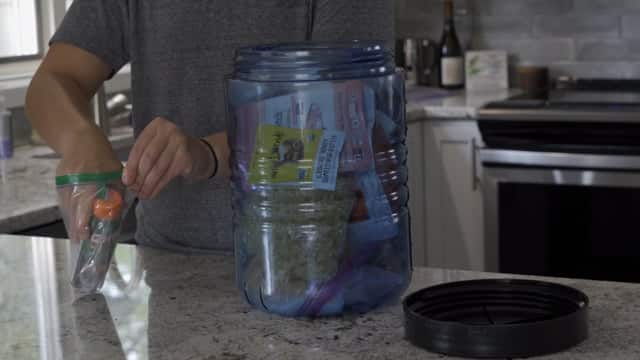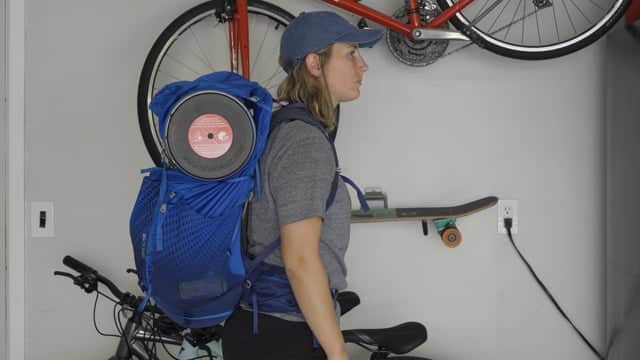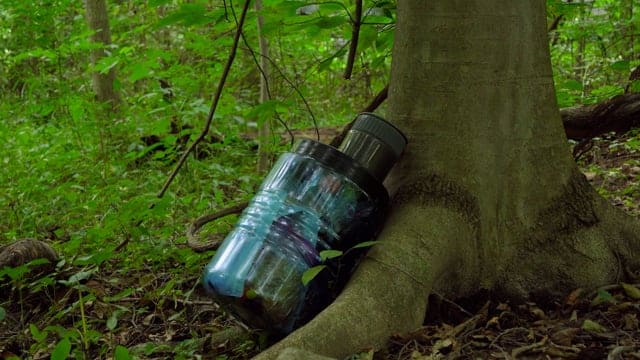TIPS & TRICKS
Open and use your canister like a pro
Video Instructions
Opening a BearVault

To Open
- Unscrew the lid counterclockwise until the black nub bumps up against the blue stopper.
- Use your finger or thumb, whatever is more comfortable, to press the nubs in towards the can and under the stopper.
- Wedging the BearVault between your knees can provide extra leverage if needed.
To Close
- Screw the lid until both nubs have clicked past the stopper.
- There is no need to twist it tight, in fact, that can make it hard to open the next time.
Cold Stiff Plastic or Weak Hands
- Simply wedge a card between the black nub and the blue stopper and leverage the card to slide the nub past the stopper.
Need-to-Knows
- Do not over tighten your lid.
- The material of the lid and the can are two different plastics. Moisture and temperature can at times cause them to contract or expand creating a tighter seal that is harder to open.
- If the lid is sticky or difficult to open or has become harder to open over time, try cleaning the threads of both the canister and the lid with a mild soap and a toothbrush, and then apply a food-grade silicon lubricant.
- Mindfully keep rim and lid threads clean.
- Sea salt, grime, and sand can impact function.
- BearVaults are water resistant versus water proof. Dry bag near lakes and oceans.
- Harsh chemicals will break down and compromise plastic and threads.
- DEET, fishing adhesives, bug sprays, paint, and any harsh chemicals need to be double bagged and kept clear of the canister plastics entirely. Avoid spraying near the canister as well.
Filling a BearVault

Plan Ahead
- Choose smart foods that are compact and light while having good nutrition
- Reconsider
- Cans
- Bulky foods
- Messy foods
- Foods with peels and remains
- Think about all the items with scents that you will need to pack. Make sure it all fits before starting your hike.
Repackage
- Use reusable storage bags
- Leave behind heavy or high volume packaging
- Remove excess space taken up by air
- Wash your hands and keep contaminants out when handling food
DEET
Always double bag DEET and any other strong chemicals before storing them in your BearVault. Chemicals will damage the plastic and can contaminate your food. Be especially careful with DEET.
At Night
- Plan to keep all scented items in your canister overnight. Be sure to leave extra room for trash and toiletries. Remember, scented items include sunblock, lip balm and mints. Double check your pockets before turning in for the night.
- Clean pots and bowls, and leave cookware outside, unless you have space left in your canister.
- As your hike progresses, fill the available space in your container with other items. to keep your load compact.
Packing a BearVault

Packing your BearVault
- Your fully loaded BearVault is one of the heaviest items in your pack. This means the ideal place is inside your pack!
- In larger packs, your BearVault is best positioned horizontally just above your sleeping bag compartment.
- If your pack is too narrow, a vertical position is the next best option. Use softer items like clothing to stuff the edges, pad your back, and make sure your load is stabilized.
- If it doesn’t work to put your canister inside the pack, position the canister near or on top of your pack with tightly secured straps. The bumps on the canister are there to help straps grip the can. Practice this option to be sure the canister clears your head and neck and is not bumping against your head while going up or down hills.
- Be mindful of your center of gravity during an uphill climb. Always keep the heaviest items as close to your back as possible to maintain your balance.
- Strapping your BearVault to the bottom of your pack is a method to be used with caution. If you do this, be sure it is tight so it will not swing into your legs or become dislodged. Use extra caution on steep downhills, as a low-hanging load can bump on rocks and launch a hiker forward.
BearVault at Camp

BearVault at Camp
- When you arrive at camp, take your BearVault out of your backpack. You don’t want a bear dragging off your pack!
- When you use your BearVault as a camp stool, fully close the lid to protect the threads. Remember, don’t over-tighten your BearVault: it is closed once both nubs have passed the stopper.
Cooking
- It’s best to cook before dark since bears become bolder at dusk. Choose a cooking site at least 100 feet downwind from where you pitch your tent.
- As you cook and eat, keep your BearVault closed. Always replace and lock the lid as soon as you have what you need.
- Use Leave No Trace principles to dispose of your cooking and cleaning water, food scraps and trash. Pack out any solids and strain liquids.
Stashing your BearVault
- Before it gets dark, scout out a place to store your BearVault for the night. Look for a place that is well away from your cooking site and is also at least 100 feet from your tent.
- The best place for your canister is under a bush or stashed between some rocks or tree roots.
- Never hang your canister in a tree; it is designed to be placed on the ground. Plus, if you happen to need something at night, it is easy to access.
- Before stashing your BearVault, check all your pockets and gear for any scented items like toothpaste, sunblock, or chapstick.
- When you stash your can, leave your cooking pots near, on top of, or in your BearVault.
Tips, Care, FAQ's
Tips & Tricks
- Pack your BearVault before you leave, to make sure all your food fits. If space is tight, consider excluding your first days’ lunch and snacks.
- Remember to allow space for scented toiletries, trash, and pet food. Some people store camp cookware in their bear canister, and if you have plenty of space it’s a good idea, but it is not necessary. Most campers simply clean their camp cookware after each use and leave it out in the open, away from their tent (it will still have some scent on it).
- If you use insect repellent with DEET, do not allow it to come into contact with your BearVault. Double-bag it in ziplocks, and ensure there is no residue outside the bags. DEET causes irreparable harm to the plastic in bear canisters, and it voids your warranty.
- Include a trash bag to keep your trash separate from your food.
- Repackage food into ziplock bags to reduce space taken by inefficient packaging materials.
- Organize food into larger ziplock sets so it is easier to locate food by meal.
- After a few days of eating, you will have extra space in your BearVault. Fill the space with other items to keep your pack as compact as it can be.
- Once your BearVault is packed with food, it will probably be the single heaviest item in your pack. You want your pack to transfer the weight onto your hips, for the most comfort and energy conservation while hiking. Ideally, you should pack heavy items close to your body and at mid-back level. In other words, layer the bottom of your pack with items that are less dense (sleeping bag, tent, inflatable sleeping pad, clothes you don’t need handy). Next place your heavy items (food, tent pegs, etc.). If your pack is wide, place the heaviest items close to your back, not far away from your back. On the top you should place remaining items, and those that you need to have handy (rain jacket, snacks for the day, etc.).
- BearVault Canisters can be strapped to a pack. There are dimples on the side that serve as strap guides, to help secure it to the pack. However, if at all possible, it is better to place the weight mid-back inside your pack.
- It is best practice to cook before dark, when possible. Bears most often visit campsites around dusk or after dark.
- When you arrive at camp, take your BearVault out of your pack and find a good place to store it. Don’t leave it in your pack!
- When you cook, take the needed food out, then immediately close the lid of your BearVault. Bears who are habituated to sites can become opportunists. Don’t give them an opportunity.
- When you close the lid, close it fully: two clicks past the stopper.
- If you sit on your BearVault, ensure the lid is fully closed to reduce wear and strain on the threads.
- Keep scents out of your tent, always. Do not eat in your tent, or brush your teeth, or apply sunblock. If you spill food on your sweater, keep it out of your tent until it is fully washed. Keep your tent “pristine” when it comes to scents.
- It is best practice to cook before dark, when possible. Bears most often visit campsites around dusk or after dark.
- When you arrive at camp, take your BearVault out of your pack and find a good place to store it. Don’t leave it in your pack!
- When you cook, take the needed food out, then immediately close the lid of your BearVault. Bears who are habituated to sites can become opportunists. Don’t give them an opportunity.
- When you close the lid, close it fully: two clicks past the stopper.
- If you sit on your BearVault, ensure the lid is fully closed to reduce wear and strain on the threads.
- Keep scents out of your tent, always. Do not eat in your tent, or brush your teeth, or apply sunblock. If you spill food on your sweater, keep it out of your tent until it is fully washed. Keep your tent “pristine” when it comes to scents.
- Open the lid by swiveling it counter-clockwise until the black nubs on the lid lock against the blue plastic stopper. With your finger or thumb, push in on the black nub, or just above the nub on the textured area, and then guide the nub past the stopper. Repeat for the second nub.
- Grip your canister between your knees for extra traction.
- If your fingers are feeling cold, sore, or weak, this process can be eased with a little trick: place a plastic card between the nub and the stopper, to help it glide past.
- If the lid is sticky or difficult to open: If it is a new canister, please contact us. If it has become harder to open over time, try cleaning the threads of both the canister and the lid with a mild soap and a toothbrush, and then apply a food-grade silicon lubricant.
- Black bears are naturally shy, but they can overcome this and become habituated to people (or even become aggressive), if they are repeatedly “rewarded” with food.
- If a black bear approaches camp or your BearVault, use noise (banging pots, yelling, whistles) and bold movements (arm waving) to ward it off. Be loud and assertive – bears can perceive the tone of your voice.
- You can move towards a bear while being assertive, but do not get too close to it or endanger yourself. Remember, bears (like all animals) have a “fight or flight” reaction to danger. If you are too close, you risk triggering a bear’s fight reaction. Always put your own safety first.
- Within the limits of your own safety, try your best to scare bears away from camping and food storage areas. Try to keep bears wild for the safety of people and for their own future.
- Many hikers now carry bear spray. Bear spray should be used as a last resort – if a bear is threatening a person – not as a scare tactic.
- Conflicts with bears should be reported to the local rangers. This helps them monitor and manage issues before they get out of hand.
- A Fed Bear is a Dead Bear: While rangers in some areas will try to relocate bears that repeatedly are in conflict with humans to remote areas, the success rate is low. Once bears have become habituated to people and human food, they tend to wander back to populated areas. In the end, most bears who frequent campsites, town trash bins and dumpsters, and other areas where they are rewarded with food will end up being put down. Each year in the USA, approximately 1000 bears are put down for this reason.
Food hangs are not ideal in most settings: trees become damaged and broken with frequent use around designated campgrounds; It is unusual to find the ideal tree limb for a food hang. Furthermore, bears have been known to climb trees and to send cubs up onto smaller limbs to pull down food hangs.
Care & Maintenance
- BearVaults are not waterproof. Please use a dry bag over the BearVault when doing water-based trips.
- Take care to keep salt off the threads. Evaporated salt can result in a sticky lid. Use a dry bag over the BearVault, and inspect/clean threads periodically.
- When you’re back home, clean the canister with mild soap and water, and store it with the lid on in a cool dry location away from UV rays.
- Wash off dirt and grime, especially on the threads.
- Do not allow salt to accumulate on the threads. Use a dry bag over your BearVault in saltwater conditions.
- Use mild soap and warm water.
- Use a clean toothbrush (or similar) to clean the threads of both the canister and the lid.
- You can put a BearVault canister in a dishwasher, using mild detergent. The lid should be hand-cleaned.
- Keep DEET and other harsh chemicals far away from your BearVault. Double-bag these in ziplocks, and be very careful not to leave residue on the outside or opening of the bags.
- Some fishing lure liquids can cause chemical damage to the plastic.
- Chemical damage can result in spontaneous stress-cracking of the canister, rendering it weak and unusable for food protection. If chemically damaged, the canister should be discarded (it cannot even be recycled with chemical damage!).
- Milky blotches or lines on the canister, sometimes accompanied by spontaneous cracking, indicate chemical damage.
- UV light also damages plastics over time. Store your BearVault in a cool dry place, out of the sun when not in use. Try to keep your BearVault in the shade and do not store it long-term in the sun. Signs of UV damage include a yellow tone to the blue canister. UV damaged canisters are not usable.
- Close the lid properly: swivel both nubs past the stopper, but do not over-tighten it.
- Lid action can be improved by applying a little food-grade silicon lubricant on the threads once a year.
FAQ's
- No. BearVault products are water resistant, but they are not designed to be submerged. We recommend putting a dry sack either inside or over your BearVault if you are using it for kayaking, canoeing, rafting, or other water-based trips.
It is possible to do this, but we don’t recommend it, because it can make it very difficult to open. Keep in mind that waterproof also means airtight. This sounds like a good thing until you consider that out in nature air pressure can change drastically with temperature and weather, causing a differential with the air pressure inside the canister. What this means is that a totally sealed lid could end up stuck in place by pressure. The better solution is to simply use a dry bag if waterproofing is important for your trip.
If you do choose to try an o-ring, there is a channel just inside the rim that could take one. If you use glue, be sure it is a water-based adhesive (not a solvent-based adhesive, which will damage and compromise the strength of the plastic). O-ring sizes that can work:
- 6.5″ ID #055 or #165 This may be a bit hard to put inside the lid as you need to stretch it 5% to get over the ridge inside the lid
- 6.75″ ID #166 or #261 This will be easier to put inside the lid as you need to stretch it only 2% to get over the ridge inside the lid
No. BearVault products reduce scent transmission, but in the nose of a bear, almost nothing is “scent-proof”. Bears have the best sense of smell of any animals on earth – that is seven times greater than that of a bloodhound. Now for some fun math – bloodhounds have a sense of smell that is 300 times greater than that of a human. That leaves bears with a sense of smell that is 2100 times greater than that of humans. It puts our little human noses into perspective!
Lots of people do this! The only word of caution is that some adhesives can damage the plastic. If possible, try to ensure stickers are using water-based adhesives (not solvent-based adhesives, which can damage and compromise the strength of the plastic).
This is not a good idea, and it will void your warranty. Most products that bind to plastics do so by chemically fusing to the plastic, damaging the structural integrity of the plastic.
BearVault’s shipping and returns policies can be reviewed on our policy page..
BearVault has been making canisters for nearly 20 years! Visit our product evolution page to learn more and see if replacement lids are available for your BearVault canister.

